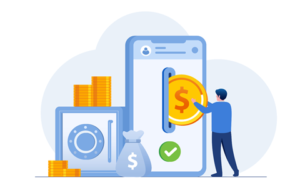Billions of people use various mobile applications every day. In fact, most of our everyday tasks can be done using mobile apps. As for June 2023, there are 8.93 million smartphone apps worldwide, just imagine such a huge amount! But not many users know how to create mobile applications. And while some of us would never need to dive deep nuances of mobile application design and development, other might think about digitalizing their business and own app development. So, let’s take a look at the process we need to go through to create an app.
Developing a mobile app is a complex process. Application needs to reflect a consistent brand identity, match your website and responsive mobile site, and encourage consumers to both download the application and convert within it. So, the first step is to start with a concept creation. Determine your goals and objectives and the ways how the new mobile app can assist in reaching these goals. Then thing about essential features and functionalities your mobile app need.
Because the majority of apps are designed for immediate or future revenue, payment solutions must be considered. Decide early on whether your app will be totally eCommerce or will contain in-app purchases and upgrades, third-party in-app adverts, or a pay-to-download model. It has a significant impact on the user interface design of your future app.
The second step is to decide on the type of the features. Don’t fall into a common trap: don’t try to embrace all features in a single application. Especially in its first version. Focus on the key ones instead. User feedback will provide you insights on the vector of the further development and this vision can be entirely different from the initial one.
Move on to the User interface design. Now, when the preparation stage is completed, your app designers will get on with visualizing the interface, selecting the colour scheme, adding graphics, and creating unique and eye-catching mobile application. In industry terms, the visualization of the future project is called a mockup, and its is needed to assess the look and practicality of the design. Pay due attention to the User Experience and visual components, they greatly impact an overall success of your app.
Developing a mobile app in the test environment is the next step. Here app developers come to the scene. The most likely scenario is delegating your app development to software development company with a proven track of record in creating various mobile apps. They know how to do an effective app development and have experience in choosing the best tools and platforms for development, testing and deploying your mobile application. Most of such vendors offer custom application development services, so you as a client don’t have to get too involved in the technical side of the project.
Every mobile application should be tested numerous times throughout development process. Usually, this scope of work is delegate to a dedicated QA (quality assurance team), that consists of both manual testers and Automated testing engineers. Their job is to make sure that every feature works as expected and most of bugs are detected before launching your product to the market.
And now comes the most thrilling and anticipated moment: the launch of your app. Remember to coordinate your marketing activities with the app development process to shape and deliver the relevant messages to your target audience at the right moment, increasing the visibility of your new application.
Once all the previous stages have been completed, your mobile application development vendor will launch your app in the app stores, so users can start download it. The most popular platforms are Apple App Store and Google Play Store.
Now keep an eye out for users’ feedback and use them as a source of valuable insight to improve your application and make it even more useful and appealing. Customers will leave reviews in the app stores commenting on their user experience, desirable new features, bugs and more.
The application development process is divided into numerous stages, beginning with ideation and design and progressing to coding, testing, and deployment. The journey, however, does not finish with the app’s launch. Its success depends on constant upgrades and continued improvement. Developers may improve the app’s functionality, fix problems, introduce new features, and maintain a seamless user experience by gathering feedback from users, monitoring performance, and staying up to date on developing technologies and consumer needs.
Are you looking for an experienced mobile app development vendor? Consider Klik Soft as your partner: with an extensive expertise in a turn-key app development, including testing and software reengineering services, we will assist you in impressing your customers with the app that everyone would like to have.



































